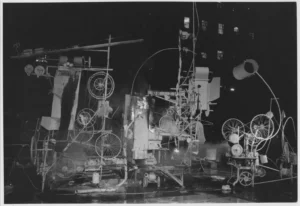In Casey Reas’ talk on chance operations, one of the most interesting ideas he explores is how randomness can act as a creative form in art. Reas shows how randomness can introduce unpredictability into structured digital systems, giving artificial creations a more natural and organic feel which he stated at the beginning of the video. Hence, made me think about how randomness is used in larger projects, like architectures and so on. For example, the designs of Expo 2020 or the Museum of the Future in Dubai bring together technology and creativity in a way that balances control with randomness, showing how both aspects can work together to create something that feels alive and evolving. Another thought that came to mind was how even small random changes can totally change the result of an algorithm. The “noise” is what keeps the system interesting, as he said without it, it’ll turn homogeneous and basically move in the same direction, which obviously isn’t exciting, and the system pretty much just becomes predictable. However, it also makes me think about things like how much randomness is good before it turns into chaos and when it stops adding to the art and starts taking away from it. One artist, for instance, Jean Tinguely, made “Homage to New York,” a machine that is meant to break itself. Yes, I get the idea of embracing chaos, but this amount of uncertainty makes it harder for me to connect. It’s too random for me to handle, and the lack of structure makes it difficult for me to connect personally with the piece. Still, I can see how some people might connect with Tinguely’s method, enjoying the randomness and how it shows how chaotic life is. In essence, too much chaos makes me feel disconnected, which shows that this type of art might not speak to everyone.
Author: Noura Alhosani
SELF PORTRAIT
For this assignment, I decided to do a simple portrait as it was my first time coding. However, I did want to play around with the background and try new codes, so I decided to do a background that changes color at random when you toggle around the mouse. At first, I thought it was too hard, and it took me time to figure out the codes, but I watched some tutorials on YouTube and went over the presentations in class, and I finally figured it out and was definitely proud of the outcome. I honestly found it difficult to figure out the shapes and where everything goes, but the Mouse X and Y function was a lifesaver, and it was a matter of getting the hang of it. The hair, however, was my least favorite part as it was getting really confusing with the placements of each circle. Maybe there was an easier way instead of just repeating each circle in a different location, so hopefully, I will figure it out in the future. Overall, after a long process of figuring out each shape, size, and code I’m happy with the outcome.
here is the background code which I am most proud of:
let x, y, r, g, b;
function setup() {
createCanvas(400, 400);
}
function draw() {
// background that changes color
background(mouseX, mouseY, 100, 7);
r = random(0, 255);
g = 0;
b = random(0, 255);
x = random(0, 600);
y = random(0, 400);
noStroke();
fill(r, g, b, 100);
circle(x, y, 24);
here is my portrait!
here is the code:
let eyeRX = 170;
let eyeLX = 225;
let speed = 15;
let x, y, r, g, b;
function setup() {
createCanvas(400, 400);
}
function draw() {
// background that changes colour
background(mouseX, mouseY, 100, 7);
r = random(0, 255);
g = 0;
b = random(0, 255);
x = random(0, 600);
y = random(0, 400);
noStroke();
fill(r, g, b, 100);
circle(x, y, 24);
print(mouseX + "," + mouseY);
//neck
fill(240, 190, 120);
stroke(0, 0, 0);
strokeWeight(1);
rect(200, 280, 70, 150, 100);
// left ear
fill(240, 190, 120);
stroke(0, 0, 0);
strokeWeight(1);
circle(135, 177, 25);
// right ear
fill(240, 190, 120);
stroke(0, 0, 0);
strokeWeight(1);
circle(264, 177, 25);
// face
fill(240, 190, 120);
stroke(0, 0, 0);
strokeWeight(1);
ellipse(200, 160, 125, 185);
//nose
noFill();
arc(199, 183, 20, 15, 270, 90);
// hair
noStroke();
fill(46, 28, 17);
// top hair
circle(140, 60, 40);
circle(183, 95, 40);
circle(205, 88, 40);
circle(160, 100, 40);
circle(170, 50, 40);
circle(200, 40, 40);
circle(230, 50, 40);
circle(233, 94, 40);
circle(260, 60, 40);
// More top curls
fill(46, 28, 10);
circle(160, 80, 40);
circle(190, 70, 40);
circle(220, 70, 40);
circle(250, 80, 40);
// Left side curls
fill(46, 28, 17);
circle(130, 90, 40);
circle(120, 120, 40);
circle(134, 135, 40);
circle(142, 113, 40);
// Right side curls
fill(46, 28, 17);
circle(270, 90, 40);
circle(280, 120, 40);
circle(262, 134, 40);
circle(256, 115, 40);
// eyebrows
stroke(21, 19, 19);
strokeWeight(2);
noFill();
arc(170, 135, 30, 10, PI, TWO_PI);
arc(225, 135, 30, 10, PI, TWO_PI);
//right eye
fill(255);
ellipse(eyeRX, 150, 20, 20);
//left eye
fill(255);
ellipse(eyeLX, 150, 20, 20);
//right pupil
fill(51, 0, 0);
ellipse(eyeRX, 150, 10, 10);
//left pupil
fill(51, 0, 0);
ellipse(eyeLX, 150, 10, 10);
// mouth up
strokeWeight(1);
fill("pink");
rectMode(CENTER);
arc(200, 209, 30, 15, PI, 0);
// mouth down
strokeWeight(1);
fill("pink");
rectMode(CENTER);
arc(200, 209, 30, 15, 0, PI);
// lip line
arc(200, 210, 27, 1, 0, PI);
//shirt
fill(126, 167, 189);
noStroke();
rect(200, 380, 199, 200, 50);
// shirt neck line
fill(240, 190, 120);
noStroke();
arc(200, 280, 90, 80, 0, PI, CHORD);
// short neck shadow
noFill();
strokeWeight(8);
stroke("#212E2D");
arc(200, 280, 90, 80, 0, PI);
noStroke();
fill(64, 102, 122);
triangle(128, 315, 135, 400, 150, 400);
triangle(265, 315, 267, 400, 250, 400);
}

